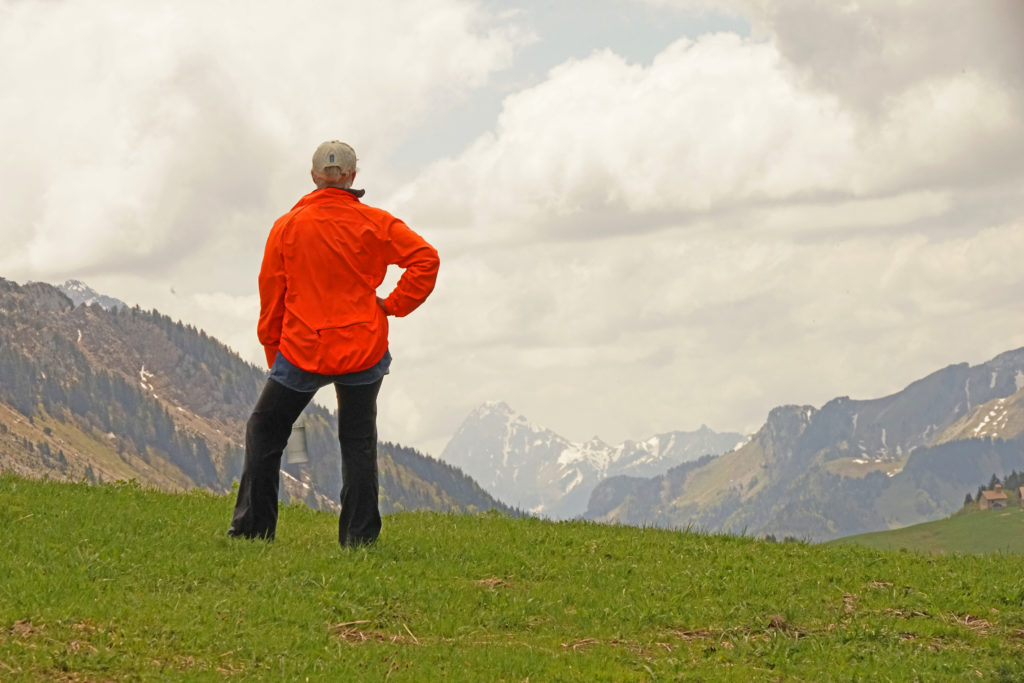
Driving up the steep switchbacks of the Savoie to a historic plateau in the French Alps, our caravan came to an abrupt stop. It didn’t take long to see – and hear – the reason why. On the narrow road in front of us, a group of French dairy farmers was shepherding a large and untethered herd of brown and white cows up to the plateau. There was absolutely no question who had the right-of-way.
The magical thing about it wasn’t just the sight, but the sound. These cows all were wearing bells — not the puny ones I remember from my youth on my uncle’s ranch in Colorado. These were large bronze bells with elaborate wide leather collars holding them in place, and as the horned heads of the cows swung to and fro, the ringing bounced off the stone walls and rang across the hollows deep and loud. The sound was a kind of cacophonous high-mountain symphony the likes of which Paula and I had never heard before. (Watch the video below)
It was Ascension Day, a national holiday in France, which we’ve learned is a strangely confused country that celebrates Catholic feast days with secular abandon. That means to celebrate the Ascension of Our Lord Jesus Christ to heaven, most people take extra days off. Ascension Day was a Thursday, so everyone also took Friday off, known as “making the bridge,” and headed out to the beaches and mountains.
Hallelujah.
So here we were, in some of the most beautiful countryside on earth, stuck behind a group of dairy cows, because it was 40 days after Easter and everyone had the day off – including the children of the dairy farmers. This cattle drive was a decidedly family affair, and the sight of young girls with large sticks confidently leading 2,000-pound animals up the steep route is one we won’t soon forget.

Now that’s what I call a cow bell. 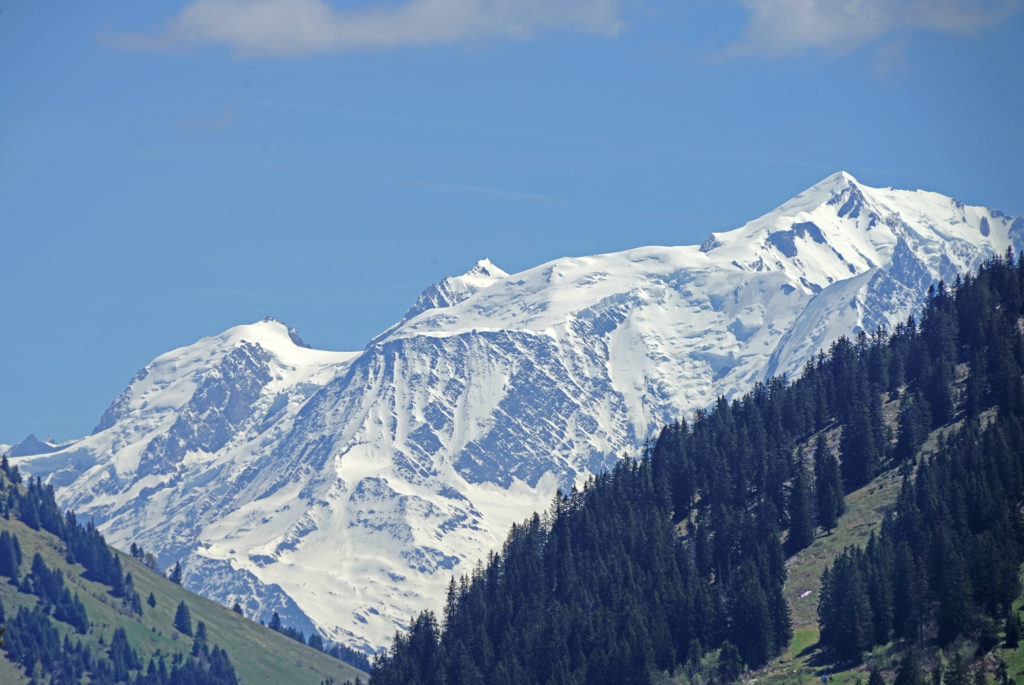
Mont Blanc, the highest point in Europe. 
The high plateaus of the Savoie are breathtaking.
Bruno drove the first vehicle of our caravan. While we were held up, he walked back to tell us that this was indeed a fortuitous occasion, as it was the day that the cows climbed from the valley pastures where they’ve spent the winter back up to the high meadows, where the fields were now thick with nourishing mountain grass and wild flowers. For the dairy cows of the Savoie, this was their own Ascension Day.
We had just arrived the night before to start four days in the mountains. When plans for the weekend had been offered up back in the winter, it was made clear that there was room for only about 25 people. Following our policy of Always Say Yes, we were Nos. 1 and 2 on the sign-up list. And finally, months later, we were here.
*****
In the iconic American poker game Texas Hold ’Em, the most American thing you can do is to go “all-in,” pushing all of your remaining chips into the center of the table. It’s a high-stakes, triumph-or-die gamble driven by one or more of three emotions: confidence, bravado, or desperation. The risk is absolute: You win big, or you lose everything. The verdict is immediate. Fans of American poker love it.
In life, gambles are rarely so clear-cut, and usually require a bit more courage than playing cards. The stakes are high, and it may be months or years before you know whether your gamble paid off.
When Paula and I decided, after less than 48 hours of contemplation, to chuck our careers, sell nearly everything we owned, buy a house in France and move permanently to Europe, it was in so many ways the ultimate all-in bet. We had not acquired inherited wealth. We were still seven years away from a hint of one Social Security check. We had done a decent job of saving for retirement – assuming we would wait until we were 66 years and 10 months old before we did anything crazy like, say, retire at 59. And with no jobs, we were without health care.
Yet during those fateful two days back in April of 2017, when we thought about the risks, it wasn’t the lack of income that scared us most. Instead, we worried about fitting in. About making friends. About learning a beautiful but difficult language deeply enough to have meaningful conversations. And about living somewhere where we had only one full-time friend within 2,000 miles (our friend Nathalie, 150 miles away in Paris.) How would we build a meaningful life as étrangers in an étrange land?
It was a concern shared by old friends and new. During our 22 months living in France, we have been asked frequently if we have any regrets. Our answer, even during the longest, wettest winter in nearly a century, was always a definitive “no.” Which was mostly accurate, but maybe not fully true. If we were being completely honest, we would have said something like, “Not yet. But it’s too early to say.”
*****
Flavigny has a tradition on Ascension weekend of putting together three days of local tours around nearby heritage sites – chateaus, abbeys and the like – combined with a trio of long walks through the Bourgogne countryside, and a pique-nique lunch. (I once told our friend Claude how cute it is when the French borrow words like “pique-nique” from English. She pointedly schooled me on how it’s a French word borrowed by Americans. Look it up.)
The decision this year to take the Ascension walks to the mountains was different, and we mostly have Carole and Bruno to thank for it. They have a long history in Flavigny, having owned and run a gite (bed and breakfast) in town called L’Ange Souriant (The Smiling Angel). A few months ago, Carole and Bruno invited us there to our first feast of tete de veau (head of the calf), a traditional French dish that is exactly what it says it is. (I tried it, and it wasn’t bad. Paula kept to the quiche.) They are generous and funny, and professional hosts.
Carole and Bruno also run a gite in a beautiful chalet in the Savoie, which is in the heart of French ski country. It’s busy in the winter and summer, but not so much in the spring. Come to les Alpes, Carole and Bruno proposed, and we’ll do the Ascension Walks in the Savoie. Paula and I knew nothing of the Savoie, but we were all in. So determined were we, that I scheduled my foot surgery for after the Ascension weekend — foot pain be damned.
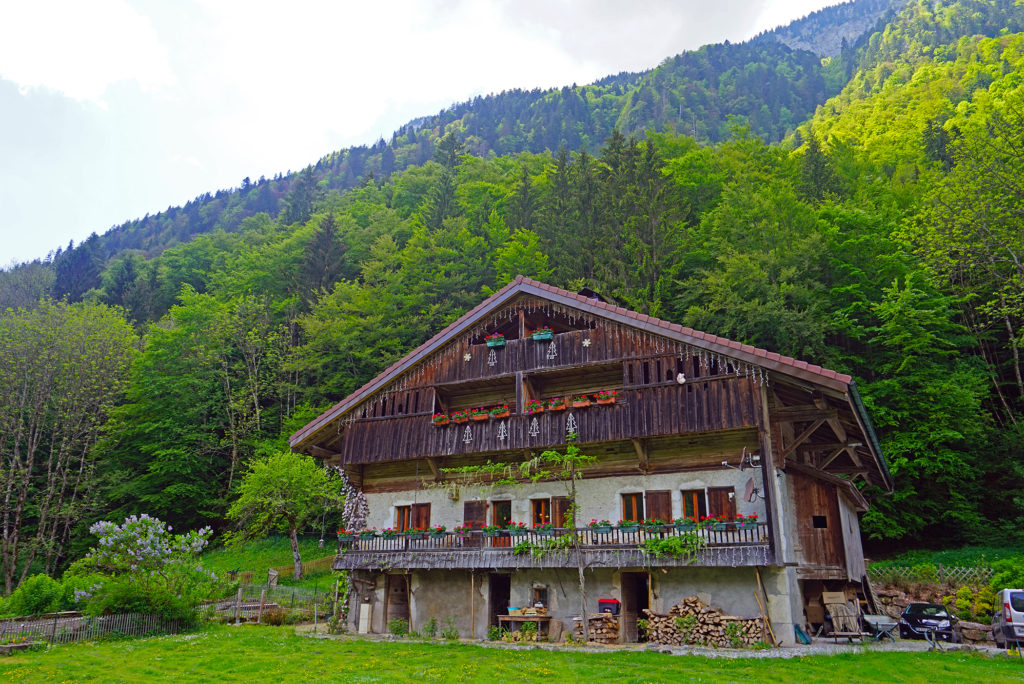
And so we found ourselves on our first morning in the French Alps on a winding road with melodious cows. As we waited, we were surprised when the farmers started to move the animals to the outside, to give us room to pass on the inside. Both our group and the cows were destined for the Plateau de Glières, famous as the Savoie’s beating heart of the Resistance during World War II.
With the plateau buried in snow for almost eight months a year, it was a great hideout for the Maquis, the French resistance fighters. They were a small but effective fighting force, wreaking havoc on German supply lines, gathering intelligence, and making it harder for the Nazis to conduct the war.
Maybe too hard. Fed up with the harassment, the Germans in March of 1944 sent 5,000 Wehrmacht troops up to the plateau against fewer than 200 maquisards, massacring almost all of them. Today, a visitor’s center and a monument with a somber chapel dominate the summit.
*****
Our first day’s Ascension Walk involved hiking across the plateau, eating our picnic (thank you, France) lunch amid postcard vistas of snow-capped peaks, visiting the Resistance monument, then hiking up to the heavenly high meadows where the cows had ascended. There, we found the farmers all enjoying a grand lunchtime feast on a glorious day outside the milking barns, and the cows enjoying their first plateau meal of the summer after the long climb.
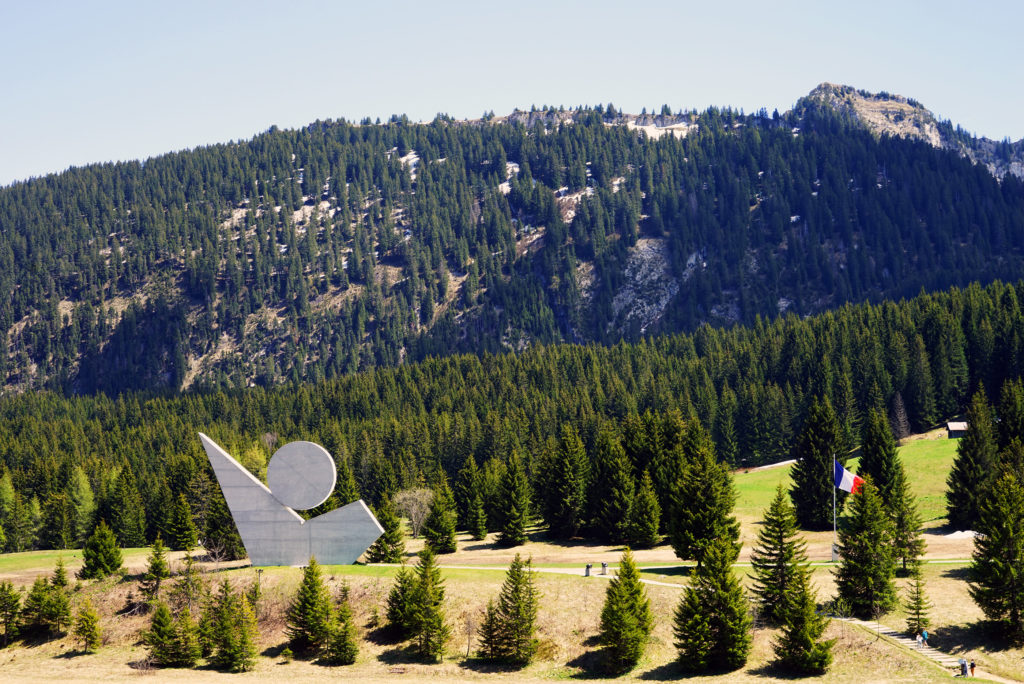
Then it was back to the chalet, where we did what the French do best. We soaked in the hot tub and swam in the pool. We drank great wine. We ate great food. We had great conversation. We shared in the beauty of being alive, and gave thanks for being able to spend the day seeing the things we got to see. We lived a whole life in one evening.
Politics was not on the menu. In fact, we would be hard-pressed to place our friends on a political spectrum. But here’s what we do know about them: They are patient and kind while we speak our bad French. We can tell you who prefers Bordeaux and who likes Burgundy. We know the best joke-tellers, even if we can’t understand the punchlines most of the time. We would recognize their laughs with our eyes closed. And whenever we have trouble navigating this new life, they are unfailingly generous with their help. At the end of the first evening, after a little too much walking and a little too much wine, we stumbled off to our rooms with sore feet and instructions for an early wake-up call.
Then we did it all over again. The second day started with a visit to a beautiful castle overlooking Lake Annecy, followed by a hike to a waterfall, followed by another celebratory night at the chalet. On Day 3, we toured an unusual Savoie museum featuring the history of the local cheese, and the history of the local ski industry. Or as Paula and I called it, the Cheese and Skis Museum. It was quirky and specific in the way that only the French seem to manage well. Then it was the hardest hike yet, along a path within sight of Mont Blanc, the roof of Europe.
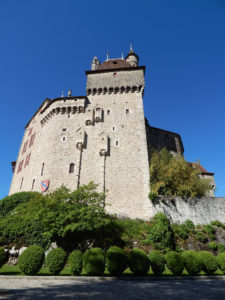
Each night in the chalet, Carole and her son Martin, a chef, prepared a feast. Our group took up both of the chalet’s large dining rooms, and on the second night, we separated by gender. That’s when I learned there are basically three kinds of French: There’s slow French, which I understand very well; there’s fast French, which I comprehend now at about 80% — enough to tell if I’ve been insulted, but not enough to always connect the dots; and then there is what I call Francais du vin, the version spoken when the wine and the laughter flow freely in equal measure. When it’s wine French, I understand almost nothing, and I get lost very quickly.
At the end of dinner in the men’s dining room, several people made a dramatic spectacle of telling jokes. Each man in turn would stand up during his telling, and would become quite theatrical in the process. I thought the standing was a little much, until I figured out they were standing up so that their sweeping arm and hand motions didn’t obliterate the tableware.
Invariably what would happen is that I would get the setup for the joke (there’s this man, and his horse, and a priest . . .), but when the critical moment arrived for the punchline, I would be lost, and find myself at a table in which I was the only one who didn’t know why I was laughing.
This is why we go to French lessons every week.
*****
In conversations with our French friends, it has become clear to us that there is no exact single word that is a corollary to the English word “home.” Not as in “la maison,” the structure in which one resides, but the deeply emotional and connective version of the word. It’s the place that answers the question, “Where is home?” The place you want to go back to when you’ve been away for a long time. It’s where your soul resides
When we decided to move to France, we knew we were leaving our longtime home in New Orleans for a life somewhere else, a place that would not instantly feel like home. After all, it takes time for a place to really grab hold of your soul, and for you to feel safe and wanted and at ease.
Toward the end of that first awful winter, during which I was sick for a time with a then-mysterious ailment that put us both on edge, I slipped slowly into a dark funk driven more by the climate than my health. Despite omnipresent fears about what was wrong with me, Paula stayed resolutely chipper and upbeat that winter, until finally one day she plunged off the cliff.
We were in bed on a gray February morning, and the cold rain started pounding on the skylight that sits just a few feet above our covers. It was something like the 80th straight day of rain, (no, I’m not exaggerating) and Paula had had enough. As tears filled her eyes, she said to me for the first (and only time): “I want to go home.”
I knew where she meant. Flavigny was still just where we lived. And it wasn’t looking all that friendly to us in that moment, given that it had started raining two months after we arrived, and was still raining three months later.

But it was a single weak moment. A place doesn’t become home in an instant. It’s a little bit like falling in love. There’s that first flush of new romance. And then you’re on a journey, to find out if the feeling will last and evolve.
*****
. . . It’s late in our first winter, a town hall “state of the village” meeting, and the mayor announces in very-fast French the new residents of Flavigny in the past year. When he says, “les O’Byrnes,” the room breaks out in heartfelt and spontaneous applause.
. . . It’s a few months later, and we’re at a large birthday party where we are two of about 100 people who have been invited to celebrate, 98 of whom are native-born French.
. . . It’s Christmas, and we’re back in New Orleans. This is where we always come back to, the place Paula was thinking about on that gray rainy morning back in February. It’s been a busy visit and we’re driving down Interstate 10 in crazy traffic, a little exhausted from the holiday demands. Paula turns to me and says, “I think I’m ready to go home.”
. . . We’re back in Flavigny a week later. It’s New Year’s Eve, and we’re at the lavoire, an open-sided stone building in the forest with a long spring-fed pool and a fireplace, where you can still hear the echoes from centuries past when the women of the village did their weekly laundry against the stones and hung it by the hearth to dry. It’s bitter cold, but as is tradition, most of the town is here.
At midnight, with the lavoire illuminated only by the candles placed along the beams, and the roaring fire, we raise our champagne glasses with our neighbors, toast the year to come. Then we sing, in French, a song that is more like a cheer, really, kind of a Bourgogne secret handshake. There’s clapping, and raising of hands into the sky. It’s hard to explain. You have to see it.
Just outside, John and Lucie, friends from Australia who own a house in Flavigny, commence a fireworks display with their sons, and everyone gathers around to watch. As Paula and I stand arm in arm, Genest, the deputy mayor, human dynamo and all-around great person, comes to us, embraces us both, and says in French, “Happy New Year. You are very good for Flavigny.”
*****

Sunday in the Alps dawned just like the three days before it, under azure skies and cool spring temperatures. We had spent three days with 25 people who we count as good friends. We had hiked, toured cultural sites, feasted, drank wine and champagne by the case, swam, soaked, sang, danced and laughed our way through the weekend.
Early in the morning, before everyone departed, Carole took Paula, Leslie, Corinne and I up to the high meadow where she keeps her horse and her mule. As is typical in this part of the world, the houses are built Swiss-style into the sides of steep hills, and you reach them by climbing higher and higher along precipitous switchbacks. Finally, we reached her pasture, which faces a breathtaking snow-covered range of Alps so close you almost have to look straight up to see the peaks.
Carole, Paula, Leslie and Corinne were tending to the animals, so I climbed the field above them with my camera. As cotton clouds skidded past the pyramids of snowy granite high above us, Carole hollered to me, “This is my paradise. What do you think?” I pulled down my camera long enough to shout back: “OH! MY! GOD!”
And yet, Carole and Bruno are leaving the Alps refuge that they love. They’re selling the chalet, and moving back to Flavigny. The way she explained it to us, to be surrounded by your friends, by the people who love and care for you, is more valuable than any amount of majestic scenery. Carole’s heart is in the high Savoie, but her soul resides in Flavigny. As she said to us, standing in the shadow of the mountains: “I have friends here, and I’ll always come back. But it’s time to go home.”
We know exactly what she meant.


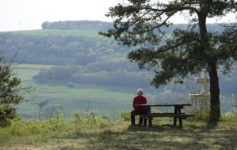

Thank you James for this lovely piece of shared moments in the Alps.
You are so right… I feel like E.T. looking the sky and say “phone home”…
Looking forward to move back Home …in Flavigny near all our beloved friends.